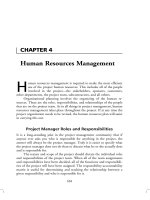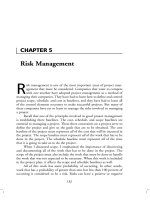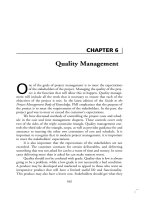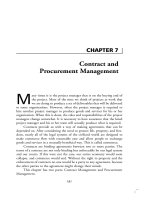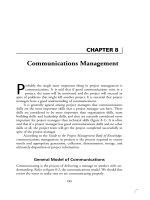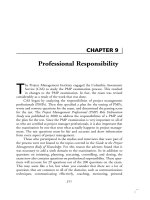Tài liệu Project Management Professional-Chapter 17b (Answer key) pptx
Bạn đang xem bản rút gọn của tài liệu. Xem và tải ngay bản đầy đủ của tài liệu tại đây (80.84 KB, 5 trang )
CONTRACTS AND PROCUREMENT
1. Answer: b
A statement of work is the description of what the project is about and what
will be delivered. The project plan is complete and contains the detailed work
that the project will do, complete with task descriptions and schedule, cost, and
scope baselines containing a real schedule and budget. An exception report
describes items that are not as planned, and a Pareto analysis is a quality man-
agement tool used to prioritize defects into the most frequently occurring.
2. Answer: a
In a fixed price contract the supplier is obligated to deliver the contracted-for
item at a fixed price. The supplier is aware of the risk and will put an allowance
for the risk in the contracted price. This often means that the project team will
pay the supplier for the cost of the risk regardless of whether the risk occurs.
3. Answer: c
The project manager should make every effort to make sure that the supplier is
aware of the risk before the contract is signed. The project manager is obligated
ethically to reveal the information to the supplier before the contract is signed.
4. Answer: b
The make or buy decision is not a contract or purchase order type. Make or
buy refers to the decision process that is used to decide whether or not work
should be done in our own facility or contracted out to a supplier.
5. Answer: c
The project charter is one of the first things that must be done in any project.
The project charter according to the Guide to the PMBOK 2000 is: ‘‘A docu-
ment issued by senior management that provides the project manager with the
authority to apply organizational resources to project activities.’’
6. Answer: d
Although it is not to the letter of the contract, the buyer is going to have much
more trouble if the seller cannot make the payroll and cannot complete the
361
9618$$ CH26 09-06-02 15:01:22 PS
362 Preparing for the Project Management Professional Certification Exam
contract because their employees will not work without pay. The best thing
would be to change the contract in some way that is mutually beneficial.
7. Answer: d
In a blanket order, a long term order is placed with the seller. The price is based
on the goods or services that will be sold over the period of the blanket order.
The seller has a long term order from the buyer and can invest in the means of
production. The buyer has a stable price for the period of the blanket order. If
the buyer does not buy all the goods or services that were promised, the price
per unit is adjusted at the end of the contract. Since the inventory is delivered
as needed, the inventory carrying cost is of no consequence to the buyer.
8. Answer: c
Forward buying is the type of purchasing where the amount of goods required
for a long period of time is purchased and delivered at one time. There is a
quantity discount for this type of purchase, but it has no effect on capital
investment unless it would be to build a place to store the goods. It will decrease
transportation cost, increase inventory, prevent the risk of future price increases,
and increase the cost associated with obsolescence.
9. Answer: d
The marketing function is not part of the procurement process.
10. Answer: d
Cost reimbursable contracts are frequently called cost plus contracts.
11. Answer: c
Work is frequently done after delivery if it is to both the seller’s and the buyer’s
mutual benefit. The cost of doing the work is charged back to the seller, thus
back charged.
12. Answer: d
Contract negotiations take place after the vendor has been selected. This is true
even in a bid situation. The seller and the buyer negotiate over the specific
terms and conditions of the contract and can even adjust the pricing. Care must
be taken here lest the unsuccessful bidders protest the adjustments and force a
rebid of the contract.
9618$$ CH26 09-06-02 15:01:22 PS
TEAMFLY
Team-Fly
®
363Contracts and Procurement
13. Answer: c
A request for proposal is a device used to solicit seller proposals. In an RFP the
seller makes proposals as to how the needs of the buyer can be satisfied. The
buyer may accept the proposal from the seller even if it is more costly than the
lowest proposal.
14. Answer: c
The request for proposal process is the most effective means of obtaining the
best seller. It puts the burden of offering the best solution to the problem on
the seller, but it creates a problem for the buyer in that the proposals will
require careful evaluation by the buyer’s team.
15. Answer: d
Our seller’s competitor’s method of outsourcing is not relevant to the make or
buy decision.
16. Answer: c
The terms ‘‘bid’’ and ‘‘quotation’’ are generally used when the source selection
decision will be price driven (as when buying commercial items), while the
term ‘‘proposal’’ is generally used when nonfinancial considerations such as
technical skills or approach are paramount (as when buying professional ser-
vices).
17. Answer: b
It is better to try to save a contract that is nearly completed than to start all
over with another vendor. There are problems in this work, and it seems likely
that the work is not clearly defined.
18. Answer: b
Existing lists of potential sellers can often be expanded by placing advertise-
ments in general circulation publications such as newspapers or in specialty
publications such as professional journals. Some government jurisdictions re-
quire public advertising of certain types of procurement items; most govern-
ment jurisdictions require public advertising of subcontracts on a government
contract.
19. Answer: a
Of the contracts listed, the cost plus percentage of cost as an award fee is the
greatest risk for the buyer and the least risk for the contractor performing the
9618$$ CH26 09-06-02 15:01:23 PS
364 Preparing for the Project Management Professional Certification Exam
work. Not only do costs go up if there are problems but the fee increases with
additional cost as well. Generally speaking, buyers prefer the fixed price con-
tract, which places more risk on the seller, and sellers prefer cost contracts,
which place more risk on the buyer.
20. Answer: b
The concept of warranty is based upon one party’s assurance to the other that
the goods will meet certain standards of quality, including condition, reliability,
description, function, or performance. This assurance may be expressed or im-
plied. Recognizing the principal function of a warranty is to establish a level of
quality (and title—not discussed herein); it thus gives a source of remedy for
loss due to a defect in the quality of the goods. The contract may and should
establish a level of quality, and if it does, it is an expressed warranty recognized
under Section 2-313 (1) (a) of the Uniform Commercial Code.
21. Answer: b
The person or organization responsible for contract administration should pro-
vide the seller with formal written notice that the contract has been completed.
Requirements for formal acceptance and closure are usually defined in the con-
tract.
22. Answer: b
Fixed price or lump sum contracts—this category of contract involves a fixed
total price for a well-defined product. To the extent that the product is not
well-defined, both the buyer and seller are at risk—the buyer may not receive
the desired product or the seller may need to incur additional costs in order to
provide it. Fixed price contracts may also include incentives for meeting or
exceeding selected project objectives such as schedule targets.
23. Answer: b
The first thing that should be done is to issue a purchase order to the contractor
and find out how much the change is going to cost. It is important in managing
changes that work on changes does not take place until the cost of doing the
change is clearly understood.
24. Answer: b
Security is a consideration in making a make-or-buy decision. In this situation
it might be very important to know how well the service bureau will be able to
protect your designs from the competition. Make or buy is a general manage-
9618$$ CH26 09-06-02 15:01:24 PS
365Contracts and Procurement
ment technique which can be used to determine whether a particular product
can be produced cost-effectively by the performing organization. Both sides of
the analysis include indirect as well as direct costs. For example, the ‘‘buy’’ side
of the analysis should include both the actual out-of-pocket cost to purchase
the product as well as the indirect costs of managing the purchasing process.
A make-or-buy analysis must also reflect the perspective of the performing
organization as well as the immediate needs of the project. For example, pur-
chasing a capital item (anything from a construction crane to a personal com-
puter) rather than renting it is seldom cost effective. However, if the performing
organization has an ongoing need for the item, the portion of the purchase cost
allocated to the project may be less than the cost of the rental.
25. Answer: b
In the procurement process, the solicitation process is the process whereby po-
tential vendors are notified of an impending contract procurement.
26. Answer: c
This is the formal and legal definition of a contract.
27. Answer: d
The contract definition includes the requirement for a contract to be agreed to
by competent parties. The person signing the contract was below the legal age
for doing so; therefore, the contract is void.
28. Answer: b
Commodities are those items that are common and readily available from sev-
eral suppliers. They are interchangeable and can be bought on the basis of price
alone, since there is little difference between vendors of these products.
29. Answer: b
When a procurement is put out for bid the resulting decision to buy from a
vendor is based on price alone. If a request for proposal was issued instead, then
it would be up to the overall evaluation of the proposal to determine the vendor
selected.
30. Answer: b
Blanket orders are promises to do business for a period of time. In this case the
trucking company has negotiated a blanket order with the tire vendor. The
discount price per tire is based on the quantities specified and forecast. If they
do not happen, the discount on all the tires sold is adjusted at the end of the
contract.
9618$$ CH26 09-06-02 15:01:25 PS



